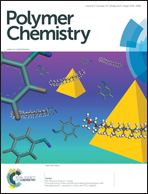Synthesis and microstructural characterization of poly(chlorotrifluoroethylene-co-vinylidene chloride) copolymers†
Abstract
The radical copolymerization of chlorotrifluoroethylene (CTFE) with vinylidene chloride (VDC) was investigated. A surfactant-free emulsion polymerization process was used to obtain poly(CTFE-co-VDC) copolymers of high molecular weight in up to 75 wt% yield. In parallel, a solution polymerization process afforded a range of poly(CTFE-co-VDC) copolymers of lower molecular weight and soluble enough to allow a meticulous characterization by NMR spectroscopy. Various statistical poly(CTFE-co-VDC) copolymers were synthesized, containing from 3 to 38 mol% of VDC. A triple resonance (1H/13C/19F) 2D-NMR 1H{13C}-HSQC (heteronuclear single quantum coherence) experiment was used to aid with resonance assignments and provided crucial information about monomer sequences. Quantitative 19F and 1H 1D-NMR enabled the determination of the composition of the copolymers. In all cases, CTFE is the less reactive of both comonomers. Decomposition temperature at 10% weight loss (T10%d values), ranged from 333 up to 400 °C under air, and a decreasing trend of the thermal stability was observed when increasing the VDC amount in the copolymer. These variations of the thermal properties were attributed to an increase in the number of C–H bonds broken in polymers with higher VDC molar percentages in the copolymer. Moreover, glass transition (Tg) and melting (Tm) temperatures ranged from 12 to 47 °C, and 162 to 220 °C, respectively.


 Please wait while we load your content...
Please wait while we load your content...